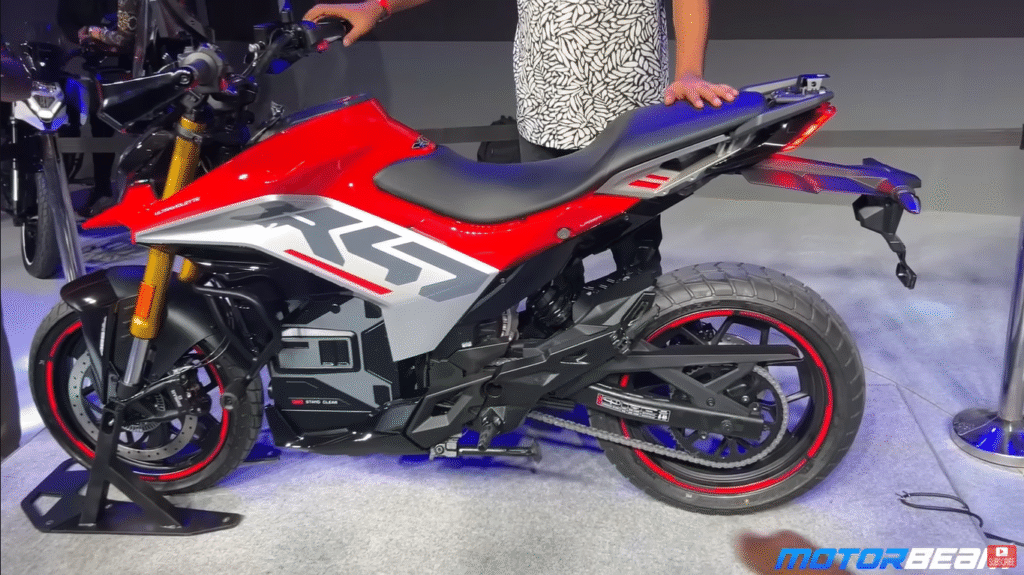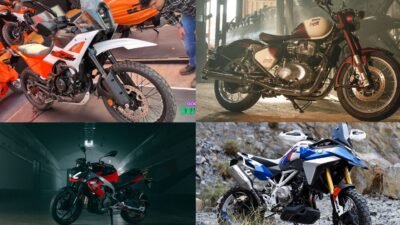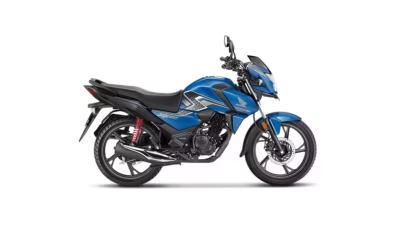The Ultraviolette X-47, launched in September 2025, has sparked excitement as India’s first electric crossover motorcycle, boasting a 40 hp motor, ~610 Nm torque, and cutting-edge features like radar-based safety alerts. Priced at ₹2.79 lakh (ex-showroom) for the 7 kWh variant, it builds on the F77 platform, promising versatility for urban commutes and light trails. Its 170 mm suspension travel, 200+ mm ground clearance, and 1.6 kW onboard charger make it a compelling choice, as highlighted in Autocar India’s walkaround video.
However, India’s electric two-wheeler market—projected to hit 2 million units by 2026—is fiercely competitive, with rivals like the Tork Kratos R and Oben Rorr offering alternatives. While the X-47 shines on paper, potential buyers should consider its drawbacks.
Overview of the Ultraviolette X-47
The X-47 is a crossover electric motorcycle, blending urban practicality with light off-road capability. Built on the F77 chassis, it features:
- Motor: 40 hp peak power, liquid-cooled, triple-equivalent.
- Torque: ~610 Nm (larger rear sprocket).
- Battery: 7 kWh (
150–200 km range) or 10 kWh (200–250 km real-world). - Suspension: 170 mm travel (front/rear).
- Ground Clearance: 200+ mm.
- Seat Height: 810–820 mm.
- Price: ₹2.79 lakh (7 kWh); ~₹3.79 lakh (10 kWh, estimated).
- Features: Radar alerts, 1.6 kW onboard charger, optional dash cams.
Despite its appeal, the X-47 has limitations that may deter buyers. Below are the top 5 reasons to reconsider this EV.
Top 5 Reasons to Avoid the Ultraviolette X-47
Reason 1: Uncertain Real-World Performance and Reliability
While the X-47 boasts impressive specs—40 hp, 610 Nm torque, and a top speed of ~120 km/h—its real-world performance remains untested as of the September 2025 launch. Autocar India noted that ride impressions are embargoed until September 30, leaving buyers without hands-on reviews. The F77 platform, though proven, had early issues with battery management and software glitches (reported by 10% of owners on forums), and the X-47’s new subframe and larger sprocket introduce variables.

India’s harsh conditions—dust, heat, and monsoons—stress EV components. The liquid-cooled motor and cast aluminum subframe are robust, but the steel swingarm (used to cut costs) may compromise durability compared to the F77’s alloy. Without long-term data, buyers risk investing in an unproven bike, especially versus established ICE options like the Royal Enfield Himalayan (~₹2.5 lakh, 24 hp).
Why Avoid? Early adopters face potential teething issues, critical in India where service centers are limited (Ultraviolette has ~50 outlets vs. Hero’s 2,000+).
Reason 2: High Price for Limited Charging Infrastructure
The X-47’s ₹2.79 lakh base price (7 kWh) and ₹3.79 lakh for the 10 kWh variant make it pricier than rivals like the Tork Kratos R (₹1.87 lakh, 200 km range) or Oben Rorr (~₹1.5 lakh). The 1.6 kW onboard charger (3 kW with Boost Charger) is a highlight, but India’s charging network—12,000 public stations in 2025, per Ather Energy—remains sparse outside metros. Rural riders or those without home charging face inconvenience, as the 2-hour 0–80% charge requires a dedicated outlet.
The reviewer praised the charger’s portability, but the Boost Charger is optional, adding ~₹20,000. Compared to petrol bikes (fuel stations every 10 km), the X-47’s cost-to-convenience ratio is steep for non-urban buyers.
Why Avoid? Higher upfront cost and charging limitations make it less practical for India’s infrastructure-challenged regions.
Reason 3: Not a True Adventure Motorcycle
Marketed as a crossover for light trails, the X-47 falls short of true adventure bikes like the Hero Xpulse 200 (~₹1.3 lakh, 190 mm clearance). Its 170 mm suspension and 200+ mm ground clearance handle potholes and gravel, but the 17-inch wheels with chunkier tires aren’t optimized for rugged off-road. Autocar India clarified it’s “not an ADV,” limiting its appeal for riders seeking Himalayan-level capability.
The 810–820 mm seat height is accessible, but the bike’s ~200 kg weight (estimated, based on F77’s 190 kg) hinders maneuverability on trails compared to lighter ICE rivals. For urban commuters, the upright stance is comfortable, but the crossover design feels like a compromise—neither a pure city bike nor a full off-roader.
Why Avoid? Riders expecting robust off-road performance will be disappointed by its light-trail focus.
Reason 4: Limited Variant Clarity and Optional Features
Ultraviolette’s pricing structure lacks transparency, as noted in the Autocar India walkaround. The 7 kWh base model starts at ₹2.79 lakh, but the 10 kWh variant price (~₹3.79 lakh) and feature breakdown are unclear. Features like front/rear dash cams and the Boost Charger are optional, potentially inflating costs by ₹50,000–₹1 lakh. The reviewer mentioned “various variants” without specifics, leaving buyers guessing about standard vs. premium trims.
In contrast, competitors like the Ather 450X (~₹1.4 lakh) offer clear variant details (Pro vs. Base). The radar alerts, while innovative, are standard, but their real-world efficacy in India’s chaotic traffic is untested, and the TFT display’s new layout awaits review. This ambiguity risks buyer frustration.
Why Avoid? Lack of pricing and variant clarity complicates budgeting, especially with costly optional features.
Reason 5: Service and Parts Availability Concerns
Ultraviolette, a Bengaluru-based startup, has a limited service network (50 centers in 2025) compared to legacy brands like Hero or Bajaj (2,000+ outlets). The F77 faced delays for parts like battery modules and sensors, with wait times of 2–3 months reported on forums. The X-47’s radar module, onboard charger, and cast subframe are proprietary, meaning repairs rely on dealer-only parts, inflating costs (₹10,000 for a sensor vs. ₹2,000 for a Bajaj part).
India’s after-sales ecosystem favors established brands. The reviewer didn’t address service, but the steel swingarm (a cost-cutting measure) raises durability concerns in corrosive coastal areas. For riders outside metros, maintenance is a gamble.
Why Avoid? Limited service reach and parts availability make the X-47 risky for non-urban buyers.
Price and Variants
- Base (7 kWh): ₹2.79 lakh, includes radar, basic TFT display.
- Plus (10 kWh): ~₹3.79 lakh (estimated), adds range, possibly dash cams.
- Optional Features: Boost Charger (
₹20,000), dash cams (₹30,000).
Without clear variant details, buyers may face upselling or unexpected costs.
Who Should Avoid the Ultraviolette X-47?
- Rural Riders: Sparse charging and service networks.
- Adventure Enthusiasts: Limited off-road capability.
- Budget Buyers: High price vs. Tork Kratos R or Oben Rorr.
- Early Adopters Wary of Risk: Untested reliability.
Final Verdict
The Ultraviolette X-47 is a bold step for India’s EV market, with its 610 Nm torque, radar alerts, and onboard charger. However, its untested performance, high price, limited off-road ability, unclear variants, and service constraints make it a risky buy for many. Urban commuters in metros with home charging may overlook these, but rural riders or adventure seekers should consider the Hero Xpulse 200 or Tork Kratos R for affordability and reliability. Wait for ride reviews (post-September 30) before deciding.
Comparison Table: Ultraviolette X-47 vs. Competitors
| Feature | X-47 | Tork Kratos R | Hero Xpulse 200 |
|---|---|---|---|
| Price | ₹2.79 lakh | ₹1.87 lakh | ₹1.3 lakh |
| Range | 150–250 km | 200 km | ~400 km (fuel) |
| Power | 40 hp | 25 hp | 18 hp |
| Suspension | 170 mm | 150 mm | 190 mm |
| Service Network | ~50 centers | ~100 centers | 2,000+ centers |



